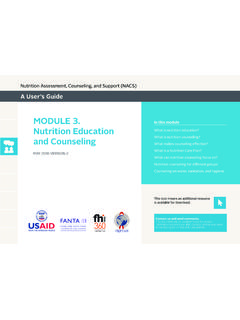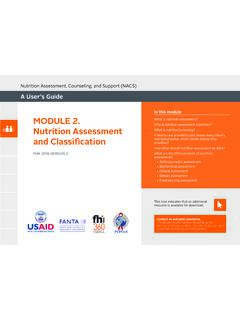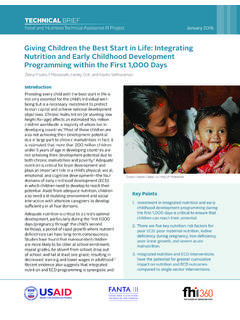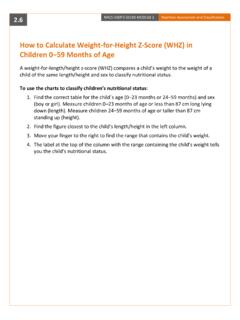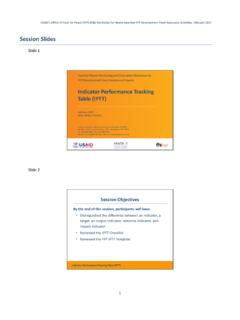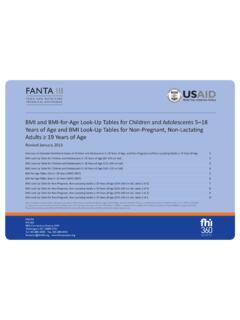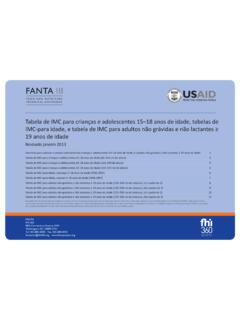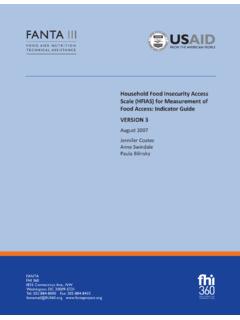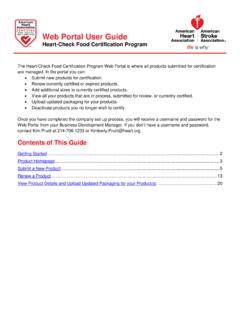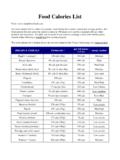Transcription of In this module MODULE 4. Nutrition Support - fantaproject.org
1 Nutrition Assessment, Counseling, and Support (NACS)A user s GuideMODULE 4. Nutrition SupportMARCH 2018 In this moduleWhat is Nutrition Support ?What Nutrition conditions are covered in this MODULE ?What are Nutrition -specific interventions under NACS?Management of moderate acute malnutritionManagement of severe acute malnutritionPrevention and treatment of micronutrient deficiencies What are Nutrition -sensitive interventions under NACS?Water, sanitation, and hygiene supportEconomic strengthening, livelihood, and food security (ES/L/FS) supportThis icon means an additional resource is available for download. Send comments and check back for document will be updated frequently as new information becomes available.
2 Consider adding your name to our mailing list to receive future AND NUTRITIONTECHNICAL A SSISTANCEPEPFAR 2 Nutrition SupportWhat is Nutrition Support ?NACS user S guide MODULE 4 WHAT IS Nutrition Support ? Nutrition Support to prevent and treat malnutrition is one of the components of Nutrition , assessment, counseling, and Support (NACS) (see MODULE 1 for more information on NACS). It includes Nutrition -specific1 interventions such as counseling on infant and young child feeding (IYCF) and optimal dietary habits and the provision of micronutrient supplements and specialized food products to address the immediate (direct) causes of malnutrition.
3 It also includes Nutrition -sensitive2 interventions that can help improve food security, nutritional status, and health outcomes, such as water, sanitation, hygiene, early childhood development, agriculture, and education interventions, as well as referral to economic strengthening and livelihood Support . Some aspects of Nutrition Support such as therapeutic and supplementary food prescriptions can only be provided by trained health care providers. However, all aspects can be promoted and supported at the community level. Note, Nutrition Support is used to address Nutrition issues only; medical treatment for co-morbidities or other illnesses should be addressed additionally by a health care provider but are not discussed in this MODULE covers the main Nutrition -specific and Nutrition -sensitive interventions that are used in NACS.
4 It discusses the following Nutrition -specific interventions: provision of micronutrient supplements and specialized food products to prevent and treat malnutrition. Two other important interventions to prevent and address malnutrition are Nutrition education and counseling. However, these interventions are covered in depth in MODULE 3 and therefore are not discussed in this MODULE . Although it is outside of the scope of this MODULE to cover all relevant Nutrition -sensitive interventions, this MODULE also covers the following Nutrition -sensitive interventions: water, sanitation, and hygiene (WASH) Support ; and economic strengthening and livelihood Bhutta, ZA et al.
5 2013. Evidence-Based Interventions for Improvement of Maternal and Child Nutrition : What Can Be Done and at What Cost? The Lancet. Vol. 382 (9890): 452 477. 2 Ruel, MT and Alderman, H. 2013. Nutrition -Sensitive Interventions and Programmes: How Can They Help to Accelerate Progress in Improving Maternal and Child Nutrition ? The Lancet. Vol. 382 (9891): 536 glossaryPhoto credit: Jessica Scranton, FANTA/FHI 360 Send a comment or check for new versions 3 Nutrition SupportNutrition Conditions: ChildrenNACS user S guide MODULE 4 What Nutrition conditions are covered in this MODULE ?AMONG CHILDREN (INCLUDING ADOLESCENTS) Stunting (chronic malnutrition) occurs when a child grows poorly because of the long-term effects of inadequate diet and/or frequent illness and is much shorter than would be expected for a healthy child the same age.
6 Stunted children are more likely to die of infectious diseases and to have compromised cognitive and motor development than well-nourished Acute malnutrition occurs when a child is wasted (too thin compared to a healthy child) because of rapid weight loss or inadequate weight gain or experiences bilateral pitting edema. It is caused by an inadequate amount or quality of food, severe and/or repeated infections, or a combination of these. It is identified using weight-for-height (children under 5), BMI-for-age (children 5 19 years), and/or mid-upper arm circumference (MUAC), and by assessing for bilateral pitting edema. Treatment is based on the severity of the condition.
7 A child with moderate acute malnutrition (MAM) is moderately wasted (low weight-for-height, BMI-for-age, and/or MUAC) and does not have bilateral pitting edema. Children with MAM are three times more likely to die of infectious diseases than well-nourished Little agreement exists on affordable and scalable treatments for MAM. However, addressing MAM is important to ensure children grow and develop optimally and to prevent their nutritional status from deteriorating to SAM. A child with severe acute malnutrition (SAM) is severely wasted (very low weight-for-height, BMI-for-age, and/or MUAC) and/or has bilateral pitting edema. Children with SAM are up to nine times more likely to die than well-nourished children5 and require urgent medical treatment and specialized foods to recover.
8 Because of breastfeeding, children under 6 months were once considered to be at low risk for SAM; however, it is now recognized that young infants are also at risk for SAM. 3 Black, RE et al. 2013. Maternal and Child Undernutrition and Overweight in Low-Income and Middle-Income Countries. The Lancet. 382 (9890): 427 451; Grantham-McGregor, S et al. 2007. Developmental Potential in the First 5 Years for Children in Developing Countries. The Lancet. 369 (9555): 60 70; Hoddinott, J et al. 2008. Effect of a Nutrition Intervention During Early Childhood on Economic Productivity in Guatemalan Adults. The Lancet. 371 (9610): 411 Black, RE et al.
9 2008. Maternal and Child Undernutrition: Global and Regional Exposures and Health Consequences. The Lancet. 371 (9608): 243 Black, RE et al. 2008. Maternal and Child Undernutrition: Global and Regional Exposures and Health Consequences. The Lancet. 371 (9608): 243 260; WHO and UNICEF. 2009. The WHO Child Growth Standards and the Identification of Severe Acute Malnutrition in Infants and Children. Geneva: WHO. Send a comment or check for new versions 4A D U LT SUnderweight/thinness occurs when an adult s weight is too low for his/her height. It can be caused by rapid weight loss over a short period, or it can reflect chronic (long-term) malnutrition.
10 Underweight/thinness may result from inadequate dietary intake (quantity or quality); severe, repeated, or chronic infections/illness ( , tuberculosis, HIV/AIDS, cancer); or a combination of inadequate diet and disease. In addition to increased risk of infection, slower recovery from illness, and increased risk of death,6 underweight adults also have reduced work capacity and In adults, underweight is categorized by degree of thinness, often referred to as degree of malnutrition (see below). Moderate malnutrition (MAM in this MODULE ) refers to moderate thinness, as identified by low BMI and/or low MUAC (under a certain cutoff). For more information on cutoffs see the MAM management section below.
